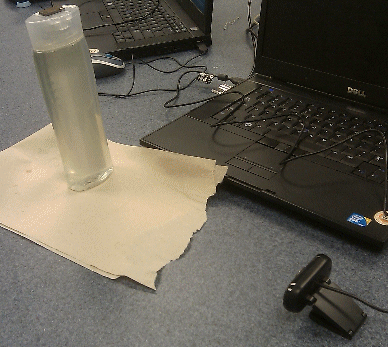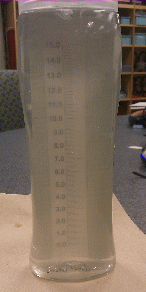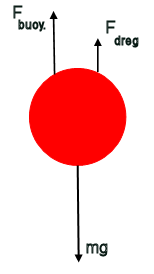Experiment
Measure the rate of descent of a steel sphere, as it falls under the
influence of gravity through the shampoo.
- Start with the steel sphere held near the middle of the lid of the
shampoo bottle
by the magnet. Make sure all the bubbles have risen and the fluid is
quiet.
- Connect a webcam to one computer.
- Start the Windows 10 Camera App and select "Take Video".
- If necessary, click the "Change Camera" icon to select the USB video device.
- Under Settings, select the video quality of 720p, 30 fps.
- Position the camera so it has a good view of the shampoo bottle and the
scale.


- Remove the magnet and wait for the ball to drop. Make sure it does
not contact the wall of the bottle.
- When the ball has fallen ~2 cm start recording.
- Stop recording when the ball reaches the bottom of the bottle. Your
video clip is automatically saved.
- Close the Camera App and double click your saved video clip under Pictures,
Camera Roll. It will
be opened and played by the "Movie and TV" App.
- Move the timeline slider to zero. Press the right
arrow key on the keyboard. Every time you press this key, the clip
advances by one frame (1/30 s). Find the frame numbers when the sphere is in front of
the scale at 12 cm, 11 cm, ..., 2 cm, by counting the number of times you had to
press t the arrow key. Enter these frame numbers into an Excel
spreadsheet.
| position (cm) |
frame number |
time (s) |
| 12 |
|
|
| 11 |
|
|
| 10 |
|
|
| 9 |
|
|
| 8 |
|
|
| 7 |
|
|
| 6 |
|
|
| 5 |
|
|
| 4 |
|
|
| 3 |
|
|
| 2 |
|
|
- Divide the frame number by 30, to find the time when the
sphere is in front of the scale at 12 cm, 11 cm, ..., 2 cm.
- Plot position (vertical axis) versus time
(horizontal axis). Verify that the plot resembles a
straight line. This verifies that the sphere moves with constant,
terminal velocity. Find the speed of the sphere by adding a linear trendline. The magnitude of the slope of this trendline
is the speed (positive number) of the sphere.
Data Analysis:
The forces acting on the sphere are gravity, the buoyant force, and the
viscous drag force given by Stokes' law. A free body diagram is shown below.

Since the sphere moves with constant velocity, the net force is zero.
- Fdrag + Fbuoyant = mg
- 6πηrspherev + ρfluidVsphereg = ρsphereVsphereg
- 6πηrspherev + (4/3)πρfluid(rsphere)3g
= (4/3)πρsphere(rsphere)3g
- η = 2(ρsphere - ρfluid)(rsphere)2g/(9 v)
The density of the "Volumizing Shampoo" is very close to that of water,
ρfluid = 1.03 g/cm3.
The density of the stainless steel ball is 7.866 g/cm3, and its
diameter is 1/4 inch = 0.635 cm.
- Calculate the viscosity η of the shampoo using
your measured velocity in units of poise = g/(cm-s).
Use the densities in units of g/cm3, the speed in units of cm/s,
the radius of the sphere in units of cm and g = 981 cm/s2.
(1 Pa-s = 1 kg/(m s) = 10 g/(cm-s) = 10 poise)
- Calculate the Reynolds number R = 2ρfluidrspherev/η.
It is a dimensionless number.
Check that the Reynolds number is less than
1, so that we are in the regime where Stokes' law is valid.
- Compare your value for η with the value obtained by the other groups.
Do the values agree?
- The table below lists typical viscosities of some viscous fluids at room
temperature. Does your value for the viscosity of the shampoo seem
reasonable? Discuss.
| fluid |
viscosity (Pa-s) |
| honey |
2 - 10 |
| molasses |
5 - 10 |
| ketchup |
50 - 100 |
| chocolate syrup |
10 - 25 |
- Predict the terminal velocity of a sphere made of the same material but with
diameter of 3/8 inch in the same fluid.
Record your results and conclusions in your log.
Convert your log into a lab report.
Name:
E-mail address:
Laboratory 8 Report
- In one or two sentences, state the goal of this lab.
- Insert your log with the requested graphs and the answers to the
questions in blue font.
Save your Word document (your name_lab8.docx), go to Canvas, Assignments, Lab
8, and submit your document.




